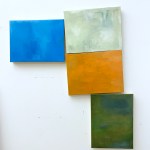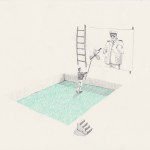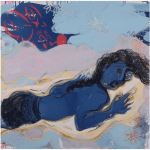
Contributed by Dana Tyrrell / From 1965 to 1967, Elizabeth Murray a towering presence in contemporary painting who died in 2007 lived and worked in Buffalo, New York. Having moved from San Francisco to teach at Rosary Hill College (now Daemen College), she used her time in Buffalo to build up to living and working in New York City. Elizabeth Murray: Back In Town, Anderson Gallery at the University at Buffalo, demonstrated that this interlude was formative to the canonically understood Elizabeth Murray. Beyond that, the show constituted a museum-class survey of the artists work as a whole the first since the Museum of Modern Arts 2005 retrospective, only the fifth one that the institution afforded a woman.
The exhibition opened with work Murray made in the years preceding Buffalo: small, dense pictures, bandaged with brushstrokes and alive with the influence of contemporaries like Jasper Johns. NH Lockwood (1964) forecasts the path of Murrays mature painting practice. One of the smallest works in the exhibition, the square, green canvas depicts a genderless face applying lipstick in a mirror. The act seems like a struggle. The bulbous face and head strain the mirrors frame, while a hand reaches from the lower left aspect, grasping lipstick but never quite making contact with the gravelly lips, as a naked lightbulb swings above.

Like other early Murray works, NH Lockwood gingerly challenges the conventionally static, flat surface of a painting. Bulging outward at the nostrils, the painting steps towards three-dimensionality. The reaching arm and hand are somewhere between brush mark and assemblage. It is a quieter painting than what Murray is best known for, but it is also a clear and important precursor of that work.
The exhibition was expansive, plotting Murrays career piece by piece across the first and second floors of the gallery. The 70-plus works included her signature curved canvases and multi-panel paintings, drawings, works on paper, and 3-D lithograph constructions. They show that her capabilities, though focused on painting, were not limited to one medium, and that she generated works of increasing audacity and originality. As the works and artist mature, the remnants of Abstract Expressionism, proto-Pop, and West Coast Funk begin to fall away.
While decidedly not representational, Murrays paintings never lose touch with identifiably tangible moments, which ground the work. The quotidian and the strange alike populate the paintings, which include things like martini olives, bed linens, intestines, and unctuous green clouds rolling off their curvy surfaces. The canvases call to recognizable forms: shards, wheels, commas, biomorphic abstraction, totems, flowers. They are by turns energetic and languid, either way seducing the viewer into close contact with surfaces caked by paint.


Sandpaper Fate (199293) was one of the most complex and ambitious paintings in the exhibition, and its gestation is traced in numerous preliminary sketches. The work feels as though it is alive. Emblematic of Murrays layered and nuanced style, the piece resembles two lungs: round, red, and plump, but also yellowing, cracked and pitted, with red veins and blue arteries of abstraction dribbling to the sides. Carving marks incise the canvass stretchers like runes, while the brushwork is broad and flat, searching for the margins as the edges of the canvas catch dribble, slippage, pentimento, and shadow. Though inexorably self-contained, the piece pulses outward from the wall.

While Buffa-nalia from Murrays brief stint in the city was absent from the exhibition itself, it was documented in photographs in the accompanying catalogue. The comparatively tentative yet distinctly fearless works Murray that made when she called Buffalo home echo down the years, shaping the arc of her unique and groundbreaking oeuvre.
Elizabeth Murray: Back In Town, Anderson Gallery, University at Buffalo, Buffalo, NY. Through October 3, 2021.
About the author: Dana Tyrrell is an artist, curator, and writer from Niagara Falls, New York. Past curatorial projects include exhibitions with the Burchfield Penney Art Center, the Castellani Art Museum, and non/profit galleries throughout Western New York. In 2018, he was selected as Curatorial Resident as part of Squeaky Wheel Film and Media Art Centers Workspace Residency.
Related posts:
Elizabeth Murrays magnificent tensions
IMHO: Elizabeth Murray, a neo-feminist icon
Elizabeth Murray: tributes and obituaries














